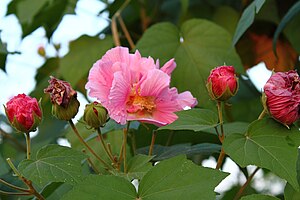Note: This is a project under development. The articles on this wiki are just being initiated and broadly incomplete. You can Help creating new pages.
Difference between revisions of "Hibiscus mutabilis"
| Line 1: | Line 1: | ||
[[File:Hibiscus mutabilis 0408.JPG|thumb|right]] | [[File:Hibiscus mutabilis 0408.JPG|thumb|right]] | ||
| − | '''Hibiscus mutabilis''' is an erect, robust, much-branched deciduous shrub or small tree growing from 1.5 - 5 metres tall. The plant is harvested from the wild mainly as a medicinal plant and source of fibre. It is widely cultivated in tropical and occasionally in temperate areas as an ornamental plant | + | '''Hibiscus mutabilis''' is an erect, robust, much-branched deciduous shrub or small tree growing from 1.5 - 5 metres tall. The plant is harvested from the wild mainly as a medicinal plant and source of fibre. It is widely cultivated in tropical and occasionally in temperate areas as an ornamental plant. |
==Uses== | ==Uses== | ||
{{Uses|Burns}}, {{Uses|Swellings}}, {{Uses|Cutaneous infections}}, {{Uses|Skin problems}}.<ref name="Uses"/> | {{Uses|Burns}}, {{Uses|Swellings}}, {{Uses|Cutaneous infections}}, {{Uses|Skin problems}}.<ref name="Uses"/> | ||
Latest revision as of 17:37, 15 May 2020
Hibiscus mutabilis is an erect, robust, much-branched deciduous shrub or small tree growing from 1.5 - 5 metres tall. The plant is harvested from the wild mainly as a medicinal plant and source of fibre. It is widely cultivated in tropical and occasionally in temperate areas as an ornamental plant.
Contents
- 1 Uses
- 2 Parts Used
- 3 Chemical Composition
- 4 Common names
- 5 Properties
- 6 Habit
- 7 Identification
- 8 List of Ayurvedic medicine in which the herb is used
- 9 Where to get the saplings
- 10 Mode of Propagation
- 11 How to plant/cultivate
- 12 Commonly seen growing in areas
- 13 Photo Gallery
- 14 References
- 15 External Links
Uses
Burns, Swellings, Cutaneous infections, Skin problems.[1]
Parts Used
Chemical Composition
Common names
| Language | Common name |
|---|---|
| Kannada | Neladavare |
| Hindi | Sthalkamal |
| Malayalam | Chinappratti |
| Tamil | Semburutti |
| Telugu | Patthi Mandaram |
| Marathi | |
| Gujarathi | |
| Punjabi | |
| Kashmiri | |
| Sanskrit | |
| English | Changeable Rose |
Properties
Reference: Dravya - Substance, Rasa - Taste, Guna - Qualities, Veerya - Potency, Vipaka - Post-digesion effect, Karma - Pharmacological activity, Prabhava - Therepeutics.
Dravya
Rasa
Guna
Veerya
Vipaka
Karma
Prabhava
Habit
Identification
Leaf
| Kind | Shape | Feature |
|---|---|---|
Flower
| Type | Size | Color and composition | Stamen | More information |
|---|---|---|---|---|
| {{{5}}} |
Fruit
| Type | Size | Mass | Appearance | Seeds | More information |
|---|---|---|---|---|---|
Other features
List of Ayurvedic medicine in which the herb is used
Where to get the saplings
Mode of Propagation
Seeds, Cuttings of half-ripe wood.
How to plant/cultivate
Hibiscus mutabilis is not a very cold-hardy plant, being able to tolerate short periods with temperatures falling to around -5°c when fully dormant.[4]
Commonly seen growing in areas
Photo Gallery
References
- ↑ Indian Medicinal Plants by C.P.Khare
- ↑ [Chemistry]
- ↑ [Morphology]
- ↑ Cultivation
External Links
- Ayurvedic Herbs known to be helpful to treat Burns
- Ayurvedic Herbs known to be helpful to treat Swellings
- Ayurvedic Herbs known to be helpful to treat Cutaneous infections
- Ayurvedic Herbs known to be helpful to treat Skin problems
- Herbs with Leaves used in medicine
- Herbs with Roots used in medicine
- Herbs with common name in Kannada
- Herbs with common name in Hindi
- Herbs with common name in Malayalam
- Herbs with common name in Tamil
- Herbs with common name in Telugu
- Herbs with common name in English
- Habit - Deciduous shrub
- Index of Plants which can be propagated by Seeds
- Index of Plants which can be propagated by Cuttings of half-ripe wood
- Herbs that are commonly seen in the region of Thickets
- Herbs
- Pages without herbs images





